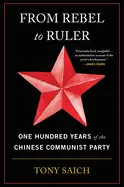
From Rebel to Ruler - by Tony Saich
ISBN: 0674293916Date read: 2024-04-10
How strongly I recommend it: 3/10
(See my list of 360+ books, for more.)
Go to the Amazon page for details and reviews.
One hundred years of the Chinese Communist Party. I thought there would be more cultural insights but it was mostly just historical facts.
my notes
Deng Xiaoping had been denounced by his radical opponents as an “empiricist.”
Deng was accused of underplaying ideology in favor of “seeking truth from facts” - empiricism!
CCP has ninety million party members: about one-tenth of China’s adult population.
Officially, China is an atheist country.
China is a culturally and linguistically diverse nation, despite attempts to produce a more monolithic and obedient society.
55 recognized national minorities occupy over 60 percent of the total land, but they account for less than 10 percent of the total population.
Most of them are in strategic border areas - a buffer zone to protect the “Han-core” from potential invaders.
China’s open, cosmopolitan south and coastal area versus the more bureaucratic northern cultures.
The influence of treaty ports and foreigners grew in cities such as Shanghai and Guangzhou (Canton), producing urban environments where non-Chinese ideas could spread and be debated.
In contrast, the north and the inland provinces were dominated by a more traditional agricultural economy and more traditional power relationships.
The CCP adopted a Leninist structure: democratic centralism.
Democratic centralism is based on three major principles:
(1) Organizational structure resembles a pyramid, with the individual subordinate to the organization and the minority subordinate to the Central Committee (CC).
(2) Collective leadership, designed to mitigate the tendency toward a dominant leader inherent in a hierarchical structure. But this has rarely worked.
(3) Protection of minority rights and the ability of members to hold views different from those of the party leadership. In principle, individuals can present their views up to and including to the CC, but they must carry out policy while awaiting a decision. In reality, neither party norms nor internal discipline operates in accordance with these strictures.
Personal factions are based on trust and loyalty that date back years.
Because individuals depend on personal patronage for career advancement, a cult develops around the faction leader and concentrates power in their hands.
Keeping that person in power becomes crucial to maintaining one’s own benefits and influence.
“50-cent party” named for the money members receive for every post they place on the internet that supports party policy.
“Class” and “class struggle” are important in the CCP’s lexicon.
Progress is explained in terms of the class struggle on behalf of the proletariat and their allies.
Parties are categorized in terms of their class composition, even if the designations bear little relationship to reality.
The main weapon for inner-party struggle is accusing opponents of corruption.
Foreigners are frequently portrayed as seeking to undermine the authority of the CCP.
Westernizing influences were indirect, through the penetration of new ideas that led to a questioning of the legitimacy of a system based around the emperor.
The CCP made good use of alliances, despite a catastrophic disaster in 1927 (when its supposed partner the GMD turned on it and slaughtered hundreds of CCP members).
Qing dynasty lasted from 1644 to 1912.
CCP has been the educator and moral conscience of the nation. There is no alternative set of institutions that can provide moral guidance to its citizens.
Deliberate fusing of the identity of party and state means that undue criticism of the party is portrayed as unpatriotic.
You are either in or out.
During the Maoist period, the household registration system tied individuals to their places of birth and made mobility extremely difficult.
The State Council in June 2014 claimed that it would “allow the trustworthy to roam everywhere under heaven while making it hard for the discredited to take a single step.”
Versailles Treaty of 1919 had ceded control of Shandong to Japan instead of returning it to China.
Intellectuals in Japan were the prime source for the radical ideas within East Asia.
Chinese tried to come to terms with their nation’s traumatic defeat in the Sino-Japanese War (1894–1895), which had been fought primarily over supremacy in Korea.
Searching for the key to Japan’s success led to an interest in the Meiji Restoration.
CCP victory in 1949 lay within the devastated landscape of China created by the years of war with Japan.”
From 1978 to the present, China went from having one of the lowest levels of inequality in Asia to having one of the highest.